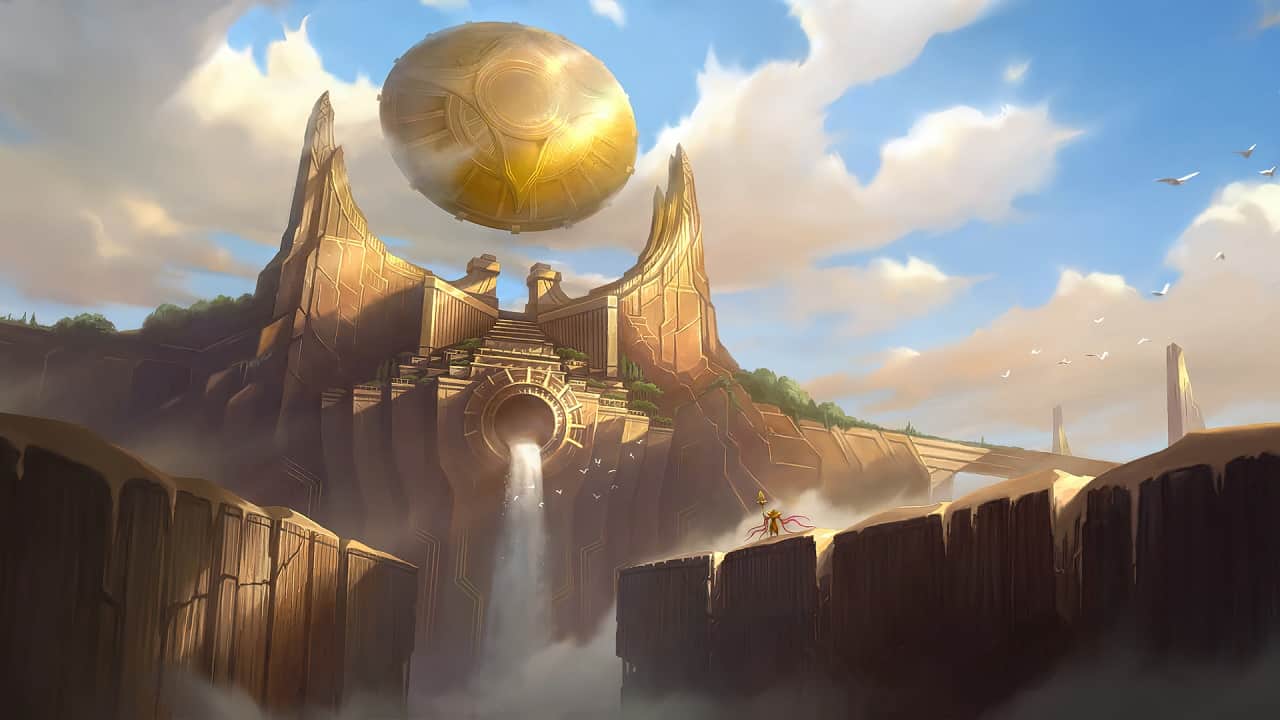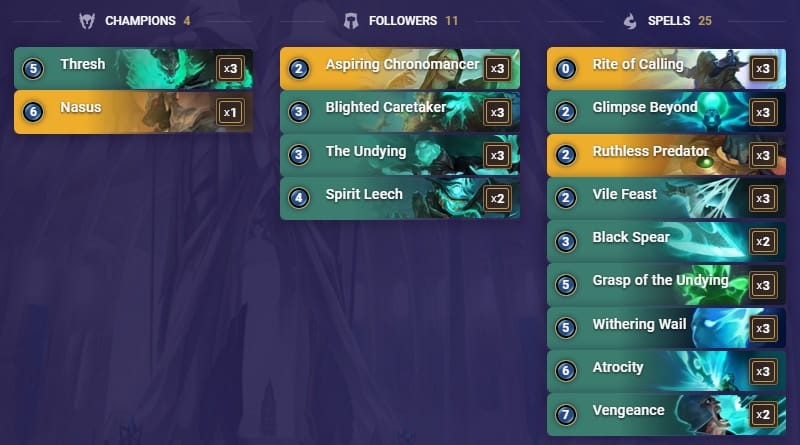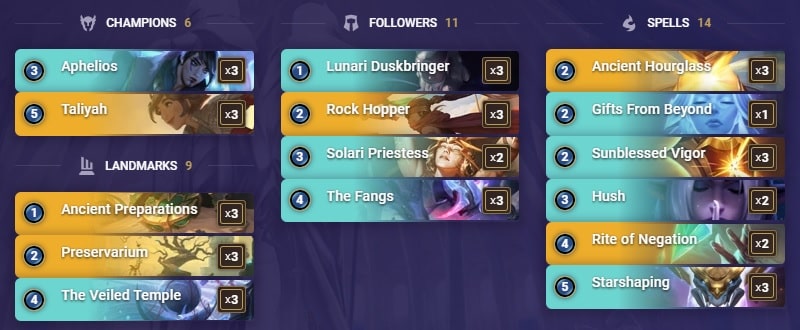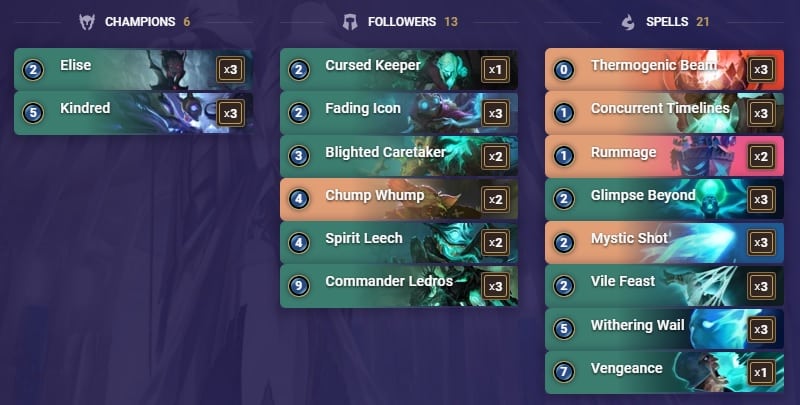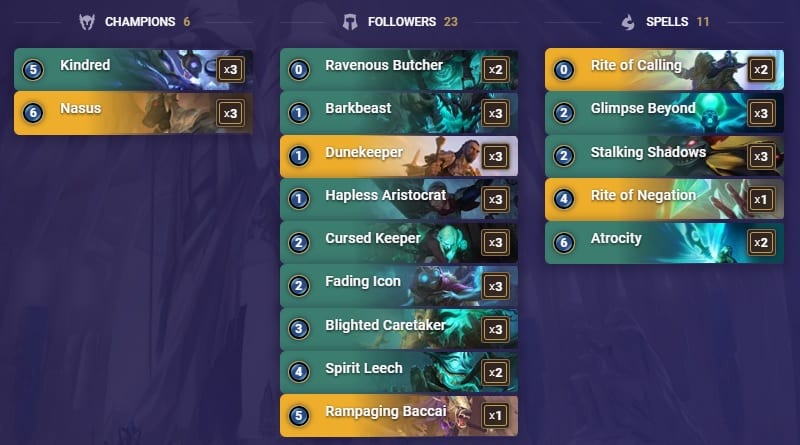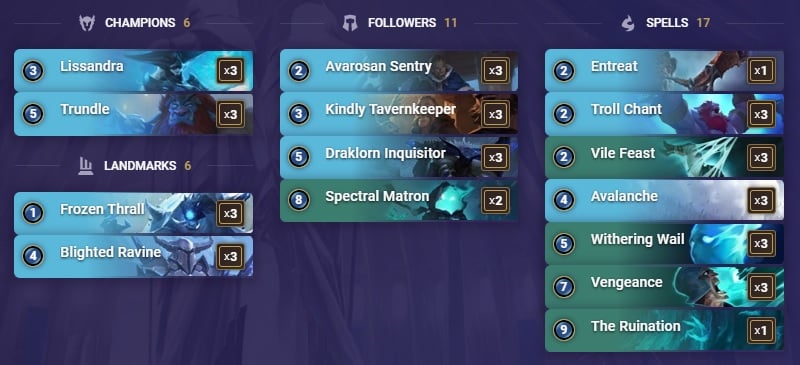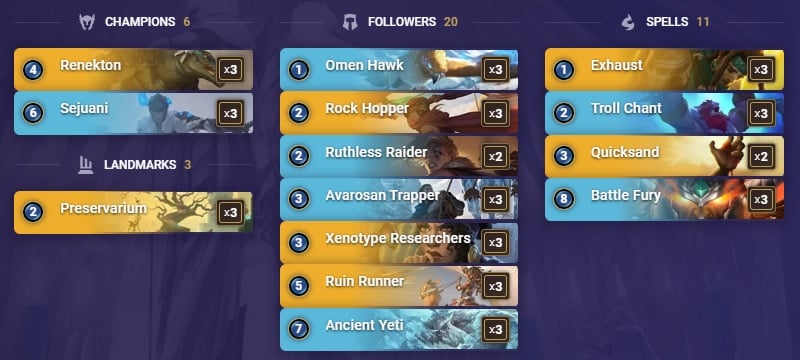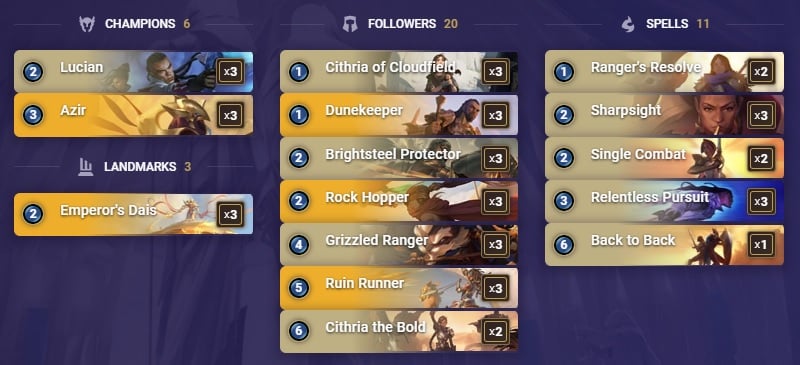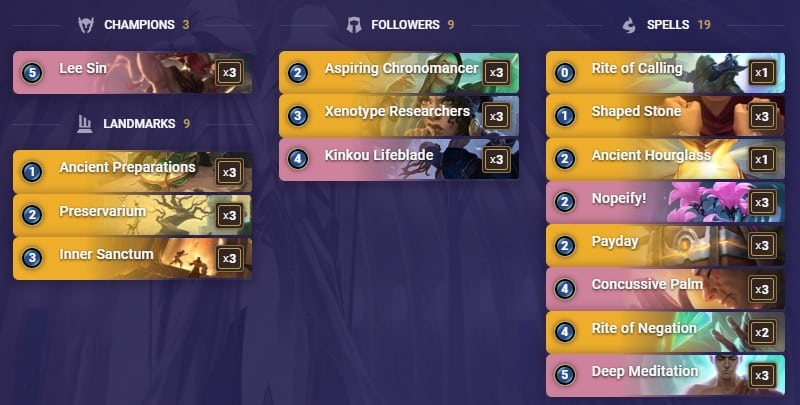Welcome to TLG’s latest article for Legends of Runeterra. Today, we’re bringing you our usual deck report, as the Shurima region expansion was released last week. The new cards have definitely injected some much-needed juice into the game, so we’re excited to give you some of the most compelling deck ideas.
Given the very early state of affairs, don’t expect much in the way of refinement. Enjoy the expansion and dive into one of these new, improved or updated archetypes.
If you have any questions, feel free to drop by our Discord. Best of luck on your climb!
Editing: Wusubi, Sebodunum
Writing: Den, Ultraman, Dartill, Othal
Table of Contents
Undying Midrange
CMBQCAQFAQBQIBYBIV4QOAIFDEOSQKJRGQ3AEAIEAUIAEAIFAERACAIEA4XQ
Difficulty: Moderate
Relevance: Not competitive
The Undying is probably the card that has received the most help in the last expansion. It gained new mechanics, a new Slay keyword, new champions that synergize with this and other new cards that are highly beneficial for the archetype (namely Rite of Calling associated with the Ascended champions).
While the deck feels too slow and unreliable at times, it can also feel like a powerhouse when things go your way. In the current state of things, very aggressive strategies tend to be a problem for Undying Midrange, as the deck suffers under lots of pressure as it wants to be focusing on setting up and building its own synergies.
Grasp of the Undying and Withering Wail are great cards, but SI without Freljord can feel a bit lacklustre at times, and a card like Avalanche could really push the deck to another level. Thresh is usually the way to handle those matchups and risk-taking is your best strategy.
Against slower decks, The Undying really has time to shine and can develop all of its value and potential. Turn after turn, the card will grow, all the while acting as the core of our strategy, allowing us to draw, remove the opponent’s board and chip away at their health. Most importantly, all this will keep stacking Nasus for the late game.
One copy of the big guy should usually be enough to close out games, and Thresh summoning him as an attacker helps him evolve the turn we get him, making Atrocity much easier to use on him afterwards. Maybe another champion such as Kindred, Elise or Kalista could be useful, but I would recommend packing removal spells for now.
The state of the game will surely prove to be too fast for such a deck to function once the meta settles and the strongest decks reveal themselves. Until then though, The Undying is a card with a great mechanic, which can end up as a gimmick that will be extremely annoying to contain if given proper time to set up. Oh and if you play this deck, you should have no qualms about bragging that you have the biggest Nasus on the block! (Write-up by Den)
Taliyah-Aphelios
CMBAKBAHBUOCMSKMAYBQSSKUMLMQDWYB3UAQEAIEA45QEAYJKVQACAIDBHLQC
Difficulty: Moderate
Relevance: Competitive
If you ever thought Lee Sin was fun, but kicking the Nexus didn’t give you the same satisfaction as hitting your opponents with a brick in the face, you came to the right place. Taliyah-Aphelios combines two of the most reliable features in recent LoR history: the Predict mechanic from Shurima and the Moon Weapons from Targon.
Your aim will be to use your draw and Predictions to get everything you need when you need it, before finishing the game with an Infernum-boosted Taliyah ravaging the enemy’s board and health.
Most of your early game cards have the dual role of setting up your champions and allowing you to slow down the pace of the most aggressive decks. Then, when Aphelios drops, his Moon Weapons will help you control the board, summon the Rock Hopper, or stun the imminent threats.
Once the board is stabilized, you can play The Veiled Temple and copy it by summoning Taliyah. Congratulations, you now have a permanent mana advantage and a Taliyah that’s only going to get bigger and bigger. Support her with Aphelios to give the killing blow, and ta-da!
However, don’t focus on this gameplan alone: the Celestials, Aphelios and the landmark-copy ability from Taliyah can also allow you to chase other win conditions, such as doubling your Aphelios via Hourglass and Taliyah, for example. While this deck may sound easy to play, keep in mind that it’s focused around your champions. Using all your available tools to keep them alive will be essential to make this deck shine. (Write-up by Othal)
Timelines OTK
CMCACBAEBIBACBA3GQBAIBIDAUCQCBI5EEUDCNIDAEBAKBABAQCRAAQBAQATUAICAECQCMA
Difficulty: Moderate
Relevance: Somewhat competitive
If you thought that LoR didn’t have enough crazy combos, you’ll be pleased with this deck, which managed to catch many players off-guard. The combo in question revolves around playing Concurrent Timelines in the early game, gaining value out of being able to choose to change your followers into 1 of 3 random other ones of equal cost.
Your goal is to play Ledros and transform him into The Dreadway, which will double Ledros’ half-Nexus damage skill into a full OTK. The value of potential highrolls on low cost followers shouldn’t be underestimated, but obviously the star of the show is this Ledros-Dreadway interaction. It should be noted that Timelines aren’t guaranteed to offer you The Dreadway as an option, but there’s a 60% chance of it happening.
This final combo has a wide array of counters, ranging from Deny to Hush and Vengeance. As such, don’t rely mainly on this to win games. Instead, focus mostly on staying in control of the board until then, dealing some damage and making sure you maximize your chances at winning even if the combo doesn’t end up landing.
Ideally, you want to play Concurrent Timelines in the very first turns of the game, since it will improve your turns 2, 3 and 4, giving you greater pressure to apply to your opponent in the early game. The main appeal of including Elise here is simply to make sure you both have tokens to act as fuel for your card draw and as fodder for Kindred activations.
Kindred is a bit of an “all or nothing” card at the moment. On the one hand, she can be easily dealt with, but on the other, she can be so destructive once safely ensconced on the board. Use cheap spells to deal with low health followers, activate Kindred on the bigger threats, and deal with them swiftly at the end of the turn! Then aim to stay in control of the game with Kindred and win thanks to Ledros! (Write-up by Ultraman)
Kindred-Nasus
CMCQCAYFAQBAEBIEAYBAIBY2F4BAIBIDAUBQCBJLGAYQGAIEA54QCBAFCABACBILDEAQEBAHBE5Q
Difficulty: Moderate
Relevance: Somewhat competitive
In a similar fashion to the old SI-Freljord Endure archetype, this is mostly a SI early game in which you splash a Shurima win condition. The differences are that now you have access to your champions more often and the opponent has to deal with an earlier, but smaller unit with Fearsome rather than Overwhelm.
Nasus being a champion doesn’t bother the deck much, if at all, and Kindred will serve as a way to ensure a hefty Nasus while also acting as a target for removal. She benefits from opponents who save their removal for Nasus, as Lamb’s marks will be gobbled up by Wolf.
Your early game is one of the best around, especially when the combination of Ravenous Butcher and Dunekeeper lands. Blighted Caretaker will also make for a great partner, focusing the attention of two defensive units far from their beloved Nexus, leaving it free for your 4/3 to damage it.
Coupling the early pressure with big followers in the late game leaves one question - what’s your finisher? Atrocity is the answer, aim to use it on Nasus when he’s leveled-up and has Spellshield. Utilize your board and damage pressure to force the opponent out of mana before landing a 10+ damage Atrocity into their Nexus! (Write-up by Ultraman)
Lissandra-Trundle
CECAEAYBAIDAGAIBAMKDEAYBAUAR2KAEAQAQCBIGBYAQCAIFFQBACAIBDUAQCBIP
Difficulty: Moderate
Relevance: Competitive
SI-Freljord once again finds a strong control deck, this time in the form of an OTK. While the concept remains the same, namely staying alive until we reach a position where we develop our win condition, the list went through huge changes.
Your win condition is an OTK synergy with Watcher, a big card that we get when Lissandra levels-up. Watcher obliterates the enemy deck simply by attacking, so it’s a powerful pay-off card. Very conveniently, Trundle proves to be a great ally to accomplish this task, his Pillar being a fantastic way to help fulfil Lissandra’s level-up condition.
Once we get Watcher in our hand, we have 3 shots at winning the game, as Spectral Matron will summon an Ephemeral version of it, forcing our opponent to come up with an answer if they want to live. The other thing about Matron is the fact that once you’ve played 2 of them, you’ve played 4+ units which cost 8, thereby activating Watcher’s zero cost condition, allowing you for a third try to win the game.
The two main concerns in this deck are how to draw and how to protect ourselves consistently. While the first part isn’t so easy to do (maybe a card like Glimpse Beyond or the new Spirit Leech could remedy this), the protecting aspect depends on what we’re expecting to face. Our healing, removal and freeze capacities need to be balanced accordingly.
With the first few days of an expansion usually bringing a plethora of aggressive decks, this defense-first archetype looks to perform well. It’s important to note that this is the least demanding OTK when it comes to cards, as only the 2 Matrons are special to the list, the rest being standard defensive tools.
While different takes on Lissandra-Trundle are appearing online, I found this one to be the most enjoyable. Atrocity-based decks, even though usually faster, need more cards to function and sometimes can get overwhelmed by good aggressive openings. Nothing prevents you from adding an Atrocity to this list as well, if you so choose. (Write-up by Den)
Renekton-Sejuani
CECACAYBAIAQEAICAQAQCBIWD4YAMBAHBMGSMLJXIMBACAQBAYAQIB3NAA
Difficulty: Easy
Relevance: Competitive
We knew that sooner rather than later, the Overwhelm keyword would have its new deck; that prediction has come true. With Shurima being a board-centric region, pushing for combat to happen and being very good at winning them, a new Frostbite-like deck emerged.
With Renekton being paired up with Sejuani, the deck lost a bit of board control ability. In exchange though, the damage output of the deck has risen considerably. Renekton couldn’t be happier than to be paired with Freljord, a region which can maximize his fighting skills.
The Overwhelm archetype without Noxus does admittedly feel strange, and even though Shurima has great arguments to be included in the deck, other variants going with the Noxian Army also exist and could be just as good.
Our goal with this deck is to dominate the board in order to have the best attack turns possible. As such, Omen Hawk and Xenotype Researchers are useful early on to buff our followers in deck, but become dispensable later on and might even cost us some tempo.
You can take some time to set up your board and control the opponent’s important units, but keep in mind that at some point you’ll have to pull the trigger and start focusing on dealing damage as a priority. Most of the time, pressure will be your answer to an annoying follower, as the damage flow forces your opponent into blocking.
The concept is simple, and we’re effectively just playing at creating a giant snowball and trying to force the opponent into a defensive position, but the deck isn’t flexible enough and your damage comes only from pressuring the board, which requires planning in order to protect our most important units.
The main limit to this deck is the lack of draw, hence the inclusion of Preservarium. There are multiple ways to build this deck, either as an on-curve enforcer or focusing more on the important units and adding draw to find them, as well as their supporting spells. 3x Battle Fury is kind of our answer to that lack of draw, as in the late game, we’ll be looking to open attack to seal the deal and this +8/+4 bonus is usually the finishing touch.
The Overwhelm archetype did great at the end of the last expansion, proving to be a fair counter to Twisted Fate decks. This deck looks strong in the early days of the expansion, but only time will tell if it’s a deck that will become a contender in the next few months. (Write-up by Den)
Lucian-Azir
CECAIAIABEKRMJYFAQDQGGRGGM3QCAYABYAQEAAJAIAQEAAHAIAQAGRTAEAQCABJ
Difficulty: Easy
Relevance: Somewhat competitive
After the nerfs to Plaza and Miss Fortune, the aggressive Demacia decks have lost the tools to claim their spot in the meta. This new deck couples Demacia and Shurima, aiming to abuse Lucian’s level-up. He has all the support he needs to evolve with Azir’s production of Sand Soldiers with every attack, as well as the Emperor’s Dais landmark.
Demacia’s great followers and the Sand Soldier mechanic make it easy to establish significant pressure in the early game. However, the problem with Sand Soldiers is that they’re Ephemeral. They don’t allow the player to establish a presence on the board from one turn to the next. As such, there’s a danger of falling behind in the mid game.
Another huge issue with this deck is that it only has one way of winning the game: board presence. Moreover, this deck is unreliable when Azir isn’t drawn early. Failing to find the Emperor is a death knell to your chances of winning. It’s crucial to adapt your mulligans for this purpose. (Write-up by Dartill)
Predict Lee Sin
CMCACAICFAAQGAQUAMBAEBIGBEDQIBYBBMGRYIZQLUAQCBAHHMAQEBAHJR4Q
Difficulty: Hard
Relevance: Somewhat competitive
Lee has a new deck, and it might be one of the best decks with Shurima thus far, even though it’s still a work in progress. Alongside the Predict mechanic and some help from the Lucky Finds, you don’t even need a second champion to make the deck work, as it looks like Lee has found what he was looking for: reliability.
This deck could be a troll, but it could also end up being a real thing down the line, once a more refined version is found. For now, just drawing Lee reliably and hoping the Lucky Finds give you something worthwhile should be enough.
The main thing I experienced with this deck is the unreliability of the Overwhelm keyword on Lee Sin. Yet, with spells like Shaped Stones and the Xenotype Researchers, our favorite monk can reach incredible levels of attack. But let’s talk about the really weird thing now: Eye of the Dragon isn’t accompanying the blind monk anymore!
Because of the way the deck functions, we don’t actually aim at playing 2 spells per turn like the Targon iteration would. Instead, the Lucky Finds can level-up Lee Sin incredibly fast. Therefore, Eye of the Dragon isn’t easy to trigger in this deck and can often stay as a 1/3 for a pretty long time. It’s the same logic with Deep Meditation, except the deck does need to draw a lot, and we can still activate it with Payday for the one time we would need it.
So, to replace this former stalwart of Lee, we’re looking for another Lifesteal unit that would benefit from the buffs that Xenotype Researchers send out into the deck. Kinkou Lifeblade and Tasty Faefolk seem like the best ones available here. Even if they have obvious limitations, the +3/+3 bonus nets us solid health gain during the game.
Personally, this is the deck I’ve had the most fun with during testing, and I believe it’s the one with the most room to grow. If you’re an avid combo player and you were afraid Shurima was going to put your favorite playstyle out of business, then rest assured, Lee Sin is still roaming the ladder, waiting to OTK someone. (Write-up by Den)

